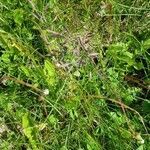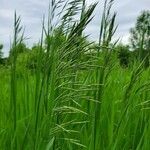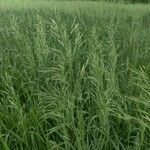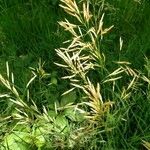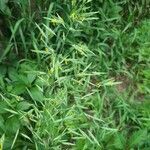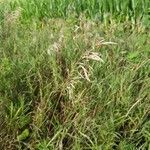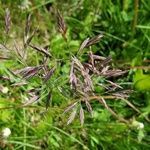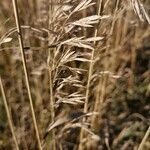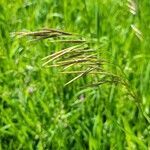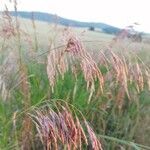Perennial, with spreading rhizomes. Culms loosely tufted, erect, 50–120 cm tall, glabrous or retrorsely hairy below nodes. Leaf sheaths glabrous or shortly hairy; leaf blades flat, 20–30 cm × 4–8 mm, both surfaces and margins scabrid, glabrous or margins sparsely ciliate, apex acuminate, ligule 1–2 mm. Panicle dense at first, spreading after anthesis, 10–20 cm; branches 3–5 per node, up to 10 cm, scabrid, each bearing 2–6 spikelets. Spikelets 15–25 mm, florets 6–12; rachilla internodes 2–3 mm, spinulose; glumes lanceolate, margins membranous, lower glume 4–7 mm, 1-veined, upper glume 6–10 mm, 3-veined; lemmas oblong-lanceolate,8–12 mm, 5–7-veined, glabrous, base scabrid, apex obtuse or emarginate; awn up to 3–4 mm, or awnless; palea shorter than lemma, keels ciliate. Anthers 3–4 mm. Fl. and fr. Jul–Sep. 2n = 14, 28, 56.
Perennial, rhizomatous. Culms 40–120 cm high. Leaves: basal sheaths glabrous; blade 37.5–40 cm long, 6–11 mm wide, glabrous. Panicles erect, contracted, 12–28 cm long; primary branches spreading. Spikelets erect, oblong, 15–30 mm long, with 5–7 bisexual florets; pedicel 6–20 mm long. Glumes unequal, keeled, with midnerve scabrous and intercostal regions glabrous; lower glume 4–8.5 mm long, 1-nerved; upper glume 6–11 mm long, 3-nerved. Callus blunt, glabrous. Basal lemma slightly laterally compressed, 8–13.5 mm long, keeled, 7-nerved (with only 3 nerves prominent); nerves scabrous; intercostal regions papillose; awn arising from sinus, to 3 mm long, straight, entered by 1 nerve. Palea slightly shorter than lemma, glabrous. Anthers 4.2–4.8 mm long.
Culms 5–10 dm from long rhizomes with dark brown scales; stems, sheaths, and blades glabrous, or the stems finely pubescent at the nodes; blades 8–15 mm wide; auricles vestigial or none; ligule 0.5–1 mm; infl 1–2 dm, open at anthesis, later contracted, often with 4–10 branches from a node; spikelets 15–30 mm, ca 3 mm wide, 7–11-fld; first glume 4–8 mm, 1-veined, the second 7–11 mm, 3-veined; lemmas 10–12 mm, 3-or 5-veined, the outer pair of veins often inconspicuous, the body obtuse or retuse, glabrous or scabrous, awnless or with an awn to 2.5 mm; 2n=28, 42, 56, 70. Native of Europe, cult. for forage and often escaped; Que. to Minn., Alta., and the Pacific, s. to Md., O., Mo., and N.M.
Perennial 500-1000 mm high, rhizomatous; old leaf sheaths flimsy, curly, not fibrous, usually glabrous. Leaf blade 200-500 x 4-7 mm, usually glabrous. Inflorescence open, branches erect or spreading; pedicels glabrous to scabrid. Spikelet 10-20(40) mm long, narrowly oblong, round to moderately laterally compressed; lower glume 1(3)-nerved, upper 3-nerved; lemmas 6.0-8.5(13.0) mm long, rounded on back, apex not distinctly bifid, acute to subacute, awnless or awned just below apex; awn fine, minute to 3 mm long; palea ciliate on keels, glabrous between keels; anthers 3-6 mm long.
Perennial, rhizomatous, up to 1 m high. Leaf blades 200-500 mm long, 4-7 mm wide. Spikelet10-20 mm long. Panicle open, pedicels glabrous to scabrid; spikelets narrowly oblong; lower glume 1-nerved, upper 3-nerved; lemmas 6.0-8.5 mm long, awns fine, up to 1 mm long.
A grass that keeps growing from year to year. It has underground stem or rhizomes. It can be in loose tufts. It grows 120 cm high. The leaf blades are 35 cm long by 4-8 mm wide. The flowers are usually dense and 10-20 cm long. The spiklets are narrow and oblong.
